
Polish Americans are Americans who either have total or partial Polish ancestry, or are citizens of the Republic of Poland. There are an estimated 8.81 million self-identified Polish Americans, representing about 2.67% of the U.S. population, according to the 2021 American Community Survey conducted by the U.S. Census Bureau. Polish Americans are the second-largest Central European ethnic group after German Americans, and the eighth largest ethnic group overall in the United States.

St. Stanislaus Roman Catholic Oratory is a Roman Catholic parish in the historic Mitchell Street District of Milwaukee, Wisconsin. It was designed by Polish nobleman Leonard Kowalski, one of Milwaukee's early Polish residents, who took the name Leonard Schmidtner and spoke German.
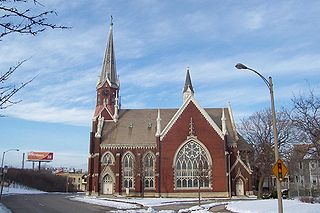
St. Stephen Lutheran Church, or Iglesia Luterana San Esteban, is a designated Milwaukee Landmark. It is in the historic Walker's Point district of Milwaukee, Wisconsin.

Saint Mary of the Angels is a historic church of Roman Catholic Archdiocese of Chicago in Chicago, Illinois.

Holy Trinity Church is a historic church of the Roman Catholic Archdiocese of Chicago located at 1118 North Noble Street. It is a prime example of the so-called 'Polish Cathedral style' of churches, in both its opulence and grand scale. Along with such monumental religious edifices as St. Mary of the Angels, St. Hedwig's or St. John Cantius, it is one of the many Polish churches that dominate over the Kennedy Expressway in the Pulaski Park neighborhood of Chicago, Illinois.
Edward Kozlowski was a Polish-American prelate of the Roman Catholic Church who served as an auxiliary bishop for the Archdiocese of Milwaukee, in Milwaukee, Wisconsin. He was the first Polish bishop for Milwaukee.
Wacław Kruszka was a Polish-American priest, journalist, social activist, and author.
St. Adalbert's Church referred to in Polish as 'Kościół Świętego Wojciecha', is a Roman Catholic Parish located at 1923 W. Becher St on Milwaukee's South Side, and one of Milwaukee's 'Polish Cathedrals.
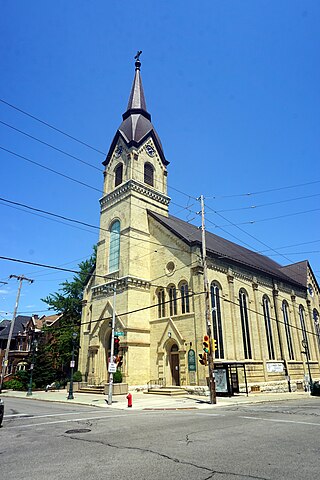
St. Hedwig's Roman Catholic Church, is a church and former parish of the Roman Catholic located at 1702 N. Humboldt Ave. on Milwaukee, Wisconsin's East Side at the center of the East Brady Street Historic District, in the Roman Catholic Archdiocese of Milwaukee.

Both immigrant Poles and Americans of Polish heritage live in Chicago, Illinois. They are a part of worldwide Polonia, the Polish term for the Polish Diaspora outside of Poland. Poles in Chicago have contributed to the economic, social and cultural well-being of Chicago from its very beginning. Poles have been a part of the history of Chicago since 1837, when Captain Joseph Napieralski, along with other veterans of the November Uprising first set foot there. As of the 2000 U.S. census, Poles in Chicago were the largest European American ethnic group in the city, making up 7.3% of the total population. However, according to the 2006–2008 American Community Survey, German Americans and Irish Americans each had slightly surpassed Polish Americans as the largest European American ethnic groups in Chicago. German Americans made up 7.3% of the population, and numbered at 199,789; Irish Americans also made up 7.3% of the population, and numbered at 199,294. Polish Americans now made up 6.7% of Chicago's population, and numbered at 182,064. Polish is the third most widely spoken language in Chicago behind English and Spanish.
The Kuryer Polski was the first Polish-language daily newspaper in the United States. It was founded by Michał Kruszka in Milwaukee, Wisconsin in June 1888.
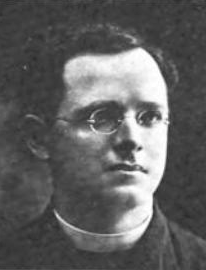
Boleslaus Edward Goral or Góral was a Polish-American priest, professor, and newspaper editor.
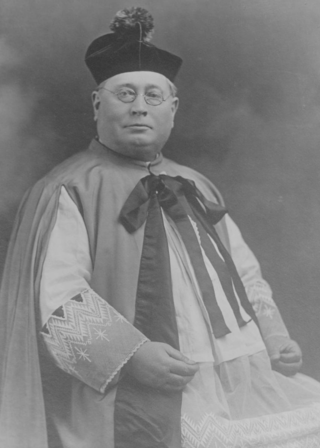
Hyacinth Gulski was a pioneer Polish-American Roman Catholic priest. He served as Archdiocesan Consultor to the Roman Catholic Archdiocese of Milwaukee.

St. Stanislaus - Bishop & Martyr Church is located at 123 Townsend Street, Buffalo, New York on the city's east side. The Church is the oldest Polish church in the Roman Catholic Diocese of Buffalo and holds the title of "Mother Church of Polonia" for western New York.
The St. Vincent de Paul Church, referred to in Polish as Kościół Świętego Wincentego a Paulo, is a parish of the Roman Catholic Church in Milwaukee, Wisconsin, in the Archdiocese of Milwaukee. Its parish church, located at 2114 W. Mitchell St. on Milwaukee's South Side, is one of Milwaukee's "Polish Cathedrals".

Old St. Mary's Church in Milwaukee, Wisconsin was built in 1846 and 1847. The parish was founded a year earlier, by German Catholic immigrants. It was the proto-German church of the Archdiocese of Milwaukee. The city had been incorporated only the year before, and Wisconsin had not yet become a state. Old St. Mary's is the oldest church still standing in the city. The building was listed on the National Register of Historic Places in 1973.

St. Patrick's Roman Catholic Church is a historic church built in 1893 at the corner of 7th and Washington Streets in Walker's Point on the near South Side of Milwaukee, Wisconsin - still very intact. The building was designated a city landmark in 1973 and added to the National Register of Historic Places the following year for its artistic and architectural significance.
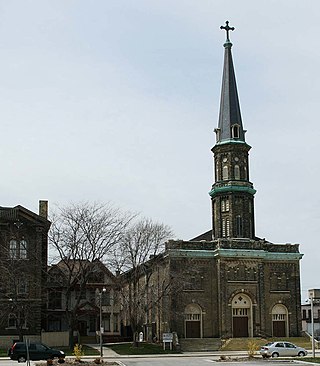
The Holy Trinity Roman Catholic Church is a historic church built in 1850 in Milwaukee, Wisconsin - now one of oldest surviving church buildings in the city, and very intact. In 1972, it was added to the National Register of Historic Places.

The Walker's Point Historic District is a mixed working-class neighborhood of homes, stores, churches and factories in Milwaukee, Wisconsin, with surviving buildings as old as 1849, including remnants of the Philip Best Brewery and the Pfister and Vogel Tannery. In 1978 it was added to the National Register of Historic Places. The NRHP nomination points out that Walker's Point was "the only part of Milwaukee's three original Settlements to reach the last quarter of the Twentieth Century with its Nineteenth and early-Twentieth Century fabric still largely intact," and ventures that "For something similar, one would have to travel to Cleveland or St. Louis if, indeed, so cohesive and broad a grouping of...structures still exists even in those cities."














